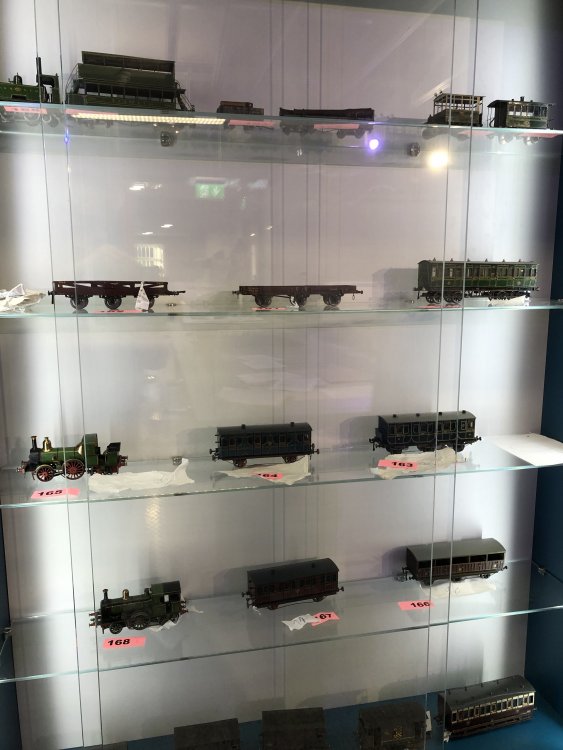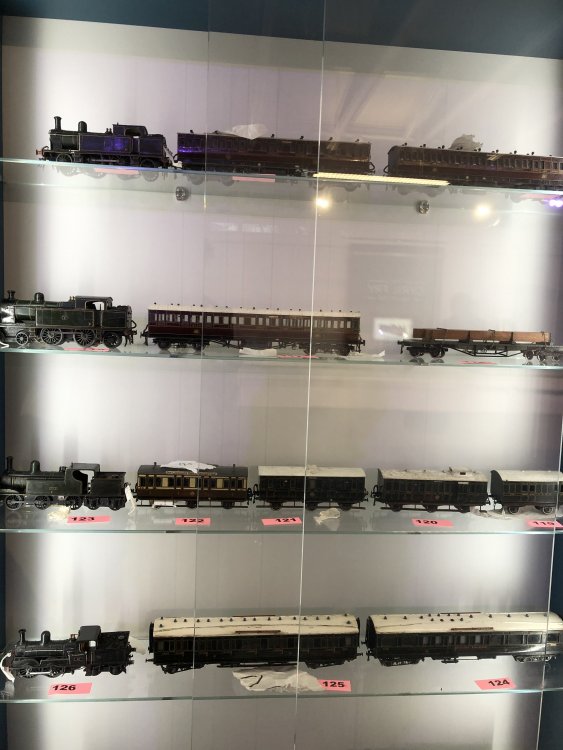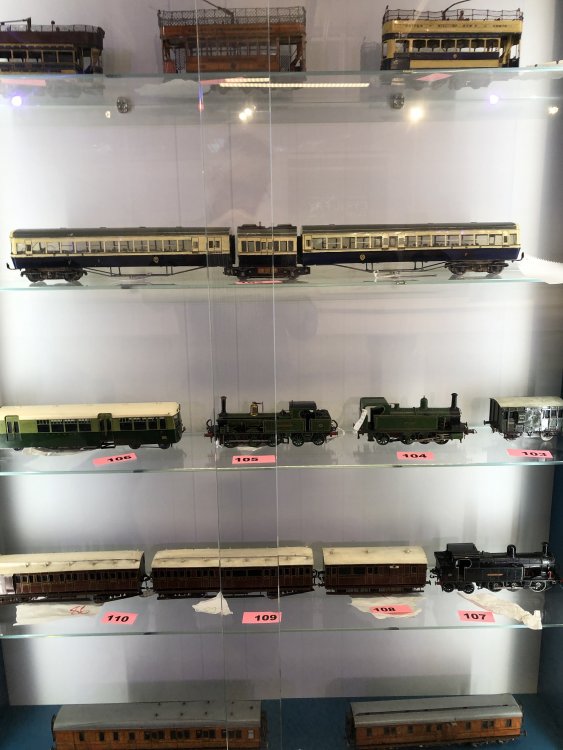-
Posts
15,845 -
Joined
-
Last visited
-
Days Won
393
Content Type
Profiles
Forums
Events
Gallery
Blogs
Store
Community Map
Everything posted by jhb171achill
-
That is stunningly realistic and prototypically spot on. Absolutely superb work, and I agree with Mr Holman’s comments on small layout track detail - “Arigna Road” set a very high standard for this sort of thing a few years ago. On first seeing the pics above I was tempted to ask “where’s the photo of the model?”!
-
Interesting. I was unaware of them. Must have been extremely short lived.
-
In the photo with B131, what are the yokes in between the 4w container wagons, anyone know?
-
Photographic Website Updates
jhb171achill replied to thewanderer's topic in Photos & Videos of the Prototype
Great selection! -
Great potential there!
-
Good thoughts, DJ!
-
I think the RPSI stock may be sold out now. I think but am not sure, I got the 2nd last one for a friend.
-
The Society still has one or two Mk 2 vehicles at Whitehead for future restoration. For those who don't know, the Society's stock of Mk 2s consists partly of vehicles from the original 1970 NIR "Enterprise" set, when the trio of ill-fated "Hunslets" were introduced. They looked very modern among NIR's increasingly dilapidated MED, MPD, AEC and BUT railcars, and elderly steam stock carriages. I remember seeing them for the first time when they were about a week in traffic. Other RPSI vehicles include ex-British Rail stock which actually never ran in Ireland at all, plus one or two that came from BR to NIR, to be used as 80-class centre cars or Enterprise stock. And one or two are ex-CIE / Irish Rail. I know that there are a couple of folks on here to state which is which. It's on the RPSI website anyway. The Society has four genny vans - two BR type and two "Dutch". Currently, the former are in Dublin and the latter at Whitehead. In each case, one in use, one not.
-
Many thanks, irishrailwayman. Just looked them up - very nice stuff, albeit perhaps a little pricey. Pity they're closing, all the same - might order one or two items.
- 68 replies
-
- passenger & goods traffic
- steam era
- (and 3 more)
-
What sort of a kit is that? I presume laser cut wood? Looks very well. Is the detail printed on or is it low-relief? Presumably door frames can be painted in a suitable colour?
- 68 replies
-
- passenger & goods traffic
- steam era
- (and 3 more)
-
Looks a BIT like that all right, but can't be certain. I won't be back in for a few days as the work I'm doing right now is all at home. I'll ping a pic when i can.
-
Update today. I have selected some of his continental stuff for one display case, and the railway signs and crests are now sorted out, positioned, and on the walls. There is a larger amount than I thought of Fry's LNWR stuff in the Reserve Collection. Most of the Reserve is the Castle layout models made by Harry Connaughton, Des McGlynn and above all Tommy Tighe. Being strictly not Fry's, this is technically outside the scope of the museum and collection, which is dedicated to Cyril Fry himself - in any event, there's no room for it. I am hoping to persuade them to include "just one more" display case so that some of Fry's LNWR coaches are included - they are truly tasty stuff, as are his two LNWR express passenger locos. The display cases now contain all of his Irish stuff, from the Schull & Skib to the Giant's Causeway; from Lough Swilly and Castlederg to the CBSCR and DSER. There's a narrow gauge navy blue turf railway loco lettered "No. 1" and "ESB" - does anyone know the details of it, as I need to finalise all the captions? So far, it's a gap both in my own knowledge (Sean Cain anywhere?) and in anything lurking here in the Catacombs at home. there's a bogie navy blue turf wagon with it. Naturally, jhb171 has some thoughts on the liveries of a small number of Fry's models - particularly a GNR "S) class 4.4.0 in railcar navy (-ish) blue! But don't worry, jhb171 will keep shtum on liveries for once. Yes, I know you'll need your smelling salts after reading that. Tonight, captions being written for the exhibits displayed on the walls - crests and loco number / name plates. There's a 3 1/2 inch gauge live steam loco. I don't know what to do with that. There's nowhere to display it - it's too big for all the cases, but it would make a fine exhibit. I am assuming Fry made it but I have no evidence to this effect. However, I made what for me was an astounding discovery today. Among Fry's crests are exact duplicates of some from my grandfather's very extensive collection, including a few from some quite obscure English companies. Both jhb--very-senior and Fry were in Inchicore at the same time, and must have known each other. One in the loco drawing office and one in the loco dept. Was there a collaboration? Both Fry and jhb-snr. were not exactly chatty when they roamed this earth..... and they're both less so these days. How, when, why? Now that the radar is up, the detective work must start. Both had "O" gauge layouts, too. I remember the jhb-snr one....huge, but not anywhere like as big as Fry's. The late Sam Carse knew Cyril Fry well - and possibly one or two of the readers here, perhaps those of us who suffer from a condition known as "too-many-birthdays syndrome". Incidentally, I was asked by a friend today what has become of the actual layout that was in Malahide Castle. Those who read here will presumably be aware that this was purpose-built for the castle and was nothing to do with Fry, and nor were any of the models that ran on it. It was dismantled in the castle in sections and these remain in store. In all reality, they're not of any value in themselves (in terms of Fry) and there's nowhere to put them anyway. Thus, they will remain in storage until or unless Fingal Council or Shannon Heritage decide what to do with them. I'll report back in due course. Back to these wretched captions. PS: The Drumm Train turned up, hidden in a box with non-layout railway artefacts! These had been missing since I saw them in the conservator's workshop months ago. The interesting thing about the Drumm train is that Fry built the models from the ORIGINAL drawings, which were done by my grandfather when in Inchicore. But when the Drumm trains were actually built, the front ends of them looked entirely different. So the two carriages you look at in the display are the way the later Drumm trains were ORIGINALLY meant to look like - not what they DID look like! These will need a separate case. I might display them along with one of the (non-Fry) DART cars that are in the Castle (Reserve) collection.
-
It was an excellent programme..... highlights for me were the Lugacurran Railway (Jim Deegan's; Jim had chauffeured Tarrant round the place) and the 80 class at Downpatrick, driven by Noel Playfair. I am sure that when Noel first joined the railway years ago that he never dreamt that he would one day drive on the BCDR main line! The "Peace Train" was of course an NIR GM and Mk 2s, rather than an 80 class - 113 was shown in the vid clip doing the honours. Several "Peace Trains" ran, and I suspect at least one, maybe more, were 80-powered. The late, great, Belfast writer Sam McAughtry (who I had met a couple of times) was the brains behind it - lovely man.
-
I wonder what's going on with the GNR railbus as late as 1960? I'm presuming it's at Dundalk? The best thoughts I can assemble are that it's being re-done for Cultra, cab removed - BUT - I do not think that ever happened to what was then 8178. CIE certainly didn't rebuild any of these. Is it possible that GTR inadvertently included a photo from, say, a few years earlier when these things were still operating to Oldcastle and Bundoran? Or, is it possible that it's been left, half-rebuilt but now abandoned, in the siding for the three years since the GNR closures took place? It's got new sheeting on the side and the cab is missing.
-
Found it! After much perusal of Gaelic script fonts, the closest to what the GSR used that I can find is: bunchló ...which can be downloaded from the Interwebnet. On this basis, the forthcoming Dugort harbour will have a sign saying: Ceide Dhubhaigh Gort DUGORT HARBOUR Or something along those lines. Incidentally, my earlier post suggested "arial narrow" as the best font for the English version - I meant, of course, just "arial"!
-
Yes, that's the type of thing. I'd go a bit smaller with the English name, a bit bigger with the Irish, but that's just a detail. Overall, looks amazing. I have a note of what the closest gaelic script on computers is - must delve. if I find it I'll post it. But that sign looks the business. Supports would be rusty-ish light green painted lengths of rail, or wooden posts with faded green that have definitely seen better days! The SLNCR, by the way, used navy blue enamel signs with English-only capital letter names. The WLWR had the same - the Collooney (South) one surviving until after closure.
-
The GSR introduced black enamel station name boards* in the late 1920s. By 1945, when CIE took over, they covered much of the system, though a few locations never had them at all, with older monolingual (English) wooden boards lasting into the 1970s CIE era. These were bilingual with the Irish name in gaelic script above, and in block Roman capitals below, the English name is a slightly smaller font. CIE continued with this. From about 1962, new CIE signs started to appear, These had white plastic backgrounds, with black lettering - a reverse of the colour scheme. the Irish name still appeared uppermost, with English below it, but both were now written in a script not unlike "arial narrow", and both written in ROMAN (not gaelic) characters of the same size font. If it's of any nitpicking interest, the posts and wooden surrounds of the old GSR enamels were normally painted GSR station green / CIE green, and usually found looking very faded, so don't use bright shiny green gloss! Some posts were wooden, but by the time most of us are modelling, uprights were usually rail. In post-1962/3 days, the surrounds to the plastic signs were normally varnished wood, with the posts grey of varying shades. (* as opposed to "running in boards". This is a term never ever heard of in Ireland!)
-
Lucky we're not in the UK, then! Superb photos, great layout. Those flats look the business.
-
Should add, also 0.6.4T “Lough Melvin”.
-
There are two SLNCR locos, a brake van, and coaches 4, and two of the bogie trio, plus Railcar B. All very nice. If I make headway with the master list of descriptions tonight and tomorrow, I’ll be back in there on Monday morning. I’ll photo them individually for you if I’ve time.
-
- 91 replies
-
- 10
-

-

.png.c363cdf5c3fb7955cd92a55eb6dbbae0.png)






